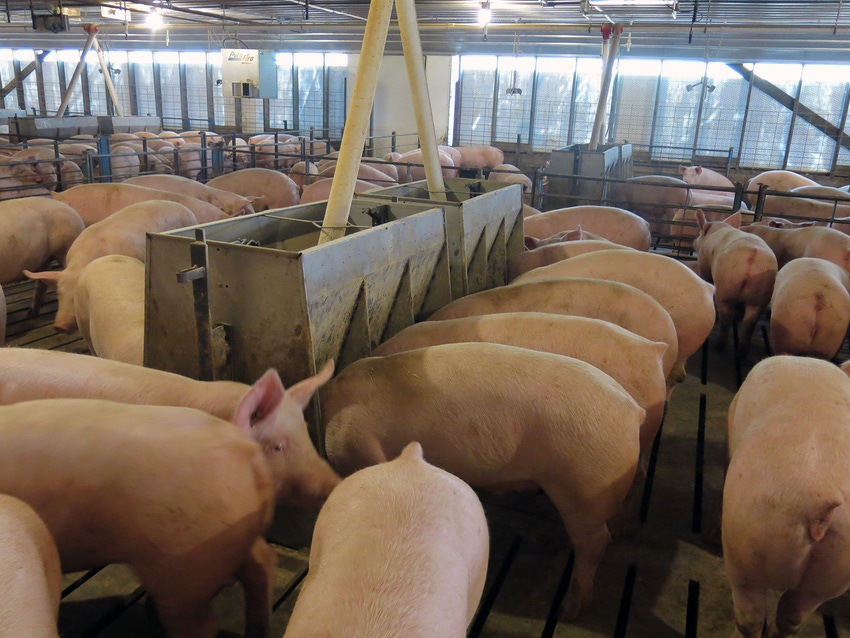Hog prices don’t explode for no reason at all
The good news is that even if my admittedly cautious expectations on these topics come true, 2018 is shaping up to be a great year.
February 5, 2018

As I’ve made the rounds of the state pork producer meetings this winter, three topics have dominated conversations: Disease losses, future of trade agreements and the potential for $90 hogs again this summer. There are a lot of opinions and a good amount of information out there on all three topics. Let’s review what is being said and what we know. Those are not necessarily the same things.
Disease losses
I wouldn’t call this year’s trade show talk hysteria at all, just intense concern and interest. And knowing something about the status of porcine reproductive and respiratory syndrome, porcine epidemic diarrhea virus and other diseases is always warranted, especially in the winter time when all of them tend to be worst. This talk is frequently full of items that are true but really don’t matter.
Example: “PRRS is the worst it’s been in the last five years.” Based on the University of Minnesota’s Bob Morrison Swine Health Monitoring Project weekly report, that statement is pretty much true. This year’s cumulative total tells us that 15% of the 910 sow herds (representing 2.456 million sows) have broken with PRRS since July 1. That number is almost precisely equal to the Jan. 28 total from 2013-14 and higher than the past three years. So, of the most recent five years counting this one, PRRS is indeed as bad as it has been at any time in those five years. But barely so, and still well below the levels of the four years previous to that period (roughly 20%, 23%, 25% and 26% reading from the U of M’s graph).
It appears to us that the incidence of PRRS in sow herds is about “normal” relative to the last five years and, as of the week ending Jan. 28, is rising at a very normal rate. The rates are indeed higher than last year by 2% to 3%, but there is nothing to suggest we are seeing dramatically different levels of PRRS activity on sow farms this year.
PEDV has barely reared its ugly head in sow barns so far this year. The U of M tally looks almost identical to all of the monitored years except one: The epidemic year of 2012-13. None of the 1,101 participating sow farms (3.026 million sows) reported a new case of PEDV for the week that ended Feb. 2. Again, there is a lot of talk about PEDV in nurseries and grow-finish but the disease causes very little death loss at these levels.
Things may be different for PEDV in nurseries or grow-finish facilities but we have no objective data to which we can compare any scuttlebutt. Spot weaned pig prices above $70 say either supplies are tight or demand is very strong. The number of pigs trading has been almost the same as last year so far in 2018. There have been some wild weekly swings but that is normal for weaned pigs. It appears supplies are good if not great, but that demand with some death losses and a lot of new finishing barns, is even better.
Future of trade agreements
This is a huge issue for the pork industry but it is relatively easy to answer at this point: We don’t know. The National Pork Producers Council goes to the mat for the U.S. pork industry every day on this topic. One day we hear that things are looking up and then a tweet from you-know-who can send everyone searching for the Maalox once again. While the North American Free Trade Agreement appropriately gets most of the attention, there is the matter of the Trans-Pacific Partnership-11 and the European Union-Japan Free Trade Agreement that have the potential to leave the United States in the dust if the administration does not make good on its promise to negotiate some effective bilateral agreements. Last year was a great year for pork and pork variety meat exports and the weakening dollar suggests that 2018 and beyond can be great, too. As long as we don’t have to overcome a bunch of tariffs that we successfully negotiated away a few years back.
What about $90 hogs?
The “yeahs” on this one point to high weaned pig prices and say “See, there just aren’t enough hogs so prices will take off again, especially with the new plants chasing the tight supply.” And there is merit in that argument. In spite of healthy increases in numbers (we have +3.25% and +4% in the second quarter and third quarter, respectively), roughly 22,000 head of new packing capacity will be operating this summer compared to last summer. And the Windom, Minn., plant which had just opened last year is still running at roughly 5,000 per day. It could happen.
But something has to create enough carcass value if hogs are going to get to the $90s, and we aren’t sure just what that could be. Last year’s $90 summer prices were virtually completely attributable to $217 primal bellies. We have a monthly average peak of roughly $150 in our belly forecasts at present due to higher hog supplies and much larger frozen belly stocks at the beginning of the year. That $67 difference would account for a $10.72 per hundredweight change in the cutout value, taking last summer’s $105 peak back to the mid-$90s assuming all other cuts are equal to one year ago; a big assumption indeed with 3-4% more of each of those cuts coming this summer.
So for hogs to get to $90, packer margins will have to be very tight. That has happened before and more capacity would suggest it is possible this year, but packers have maintained margins pretty well and, while good, drop values are not near large enough right now to suggest that packers could (or would) run on zero meat margins for very long.
The Bottom Line
The good news is that even if my admittedly cautious expectations on these topics come true, 2018 is shaping up to be a great year. Costs are low. No existing trade agreements have been destroyed. More packing capacity is operating. Domestic demand finished 2017 strong and consumer attitudes are quite positive. The dollar remains weaker than it once was but by no means weak in a historical context. Most things are good for pork producers.
And pitchers and catchers begin reporting to spring training this week. Is this a great country or what?
About the Author(s)
You May Also Like





